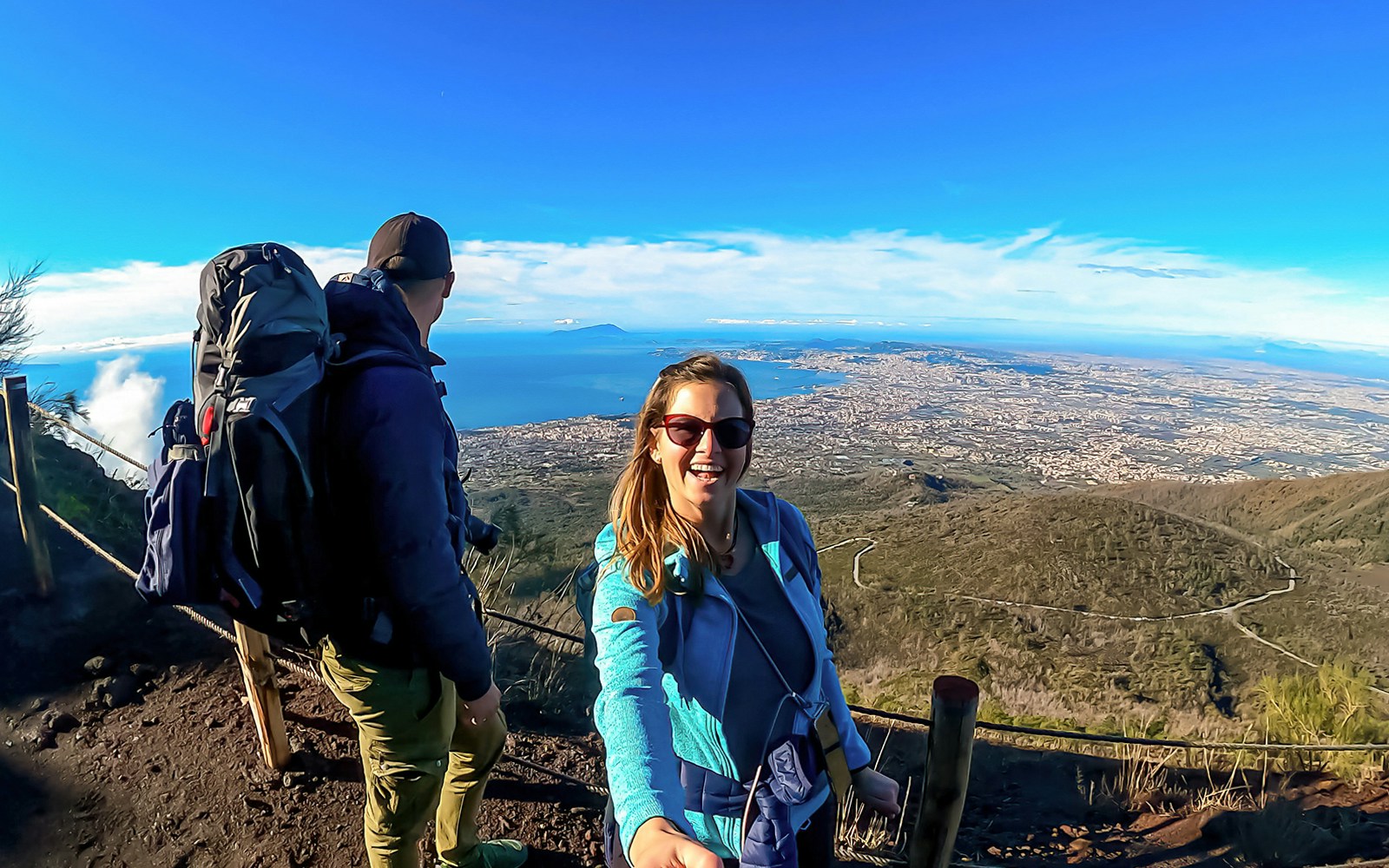- Pompeii Tickets & Tours
- Herculaneum Tickets
- Royal Palace of Naples
- Museo Di Capodimonte
- Villa Pignatelli
- Museo Archaelogico Nazionale di Napoli
- Certosa di San Martino
- Catacombs of San Gennaro, Naples Tickets
- Città della Scienza
- Bourbon Tunnel
- Naples Underground
- Maradona Tours
- Artecard Naples City Pass
- Veiled Christ
- Alibus Airport Transfers
Exploring the Depths of Mount Vesuvius Crater
Why Go Up To The Crater?

- Unparalleled Panoramic Views: As you ascend to the crater, prepare to be rewarded with breathtaking panoramic views of the Bay of Naples that stretch as far as the eye can see.
- Step into Ancient History: The infamous eruption of 79 AD, which preserved and ultimately revealed the cities of Pompeii and Herculaneum, adds a layer of historical significance to your visit. Standing at the crater, you'll gain a deeper appreciation for the cataclysmic event that forever shaped ancient civilizations.
- Outdoor Exploration: The journey to the crater is an exhilarating outdoor adventure. Trekking along winding paths and rugged terrain, you'll feel the rush of adrenaline as you conquer the ascent.
- Uncover Geological Wonders: Explore the geological marvels that make Mount Vesuvius truly unique. Marvel at the layers of volcanic ash and hardened lava, a testament to the volcano's explosive history
Geolological Highlights Of Mount Vesuvius Crater

Crater Formation
The Mount Vesuvius Crater is a result of past volcanic eruptions. It is a large, bowl-shaped depression at the summit of the volcano, formed by the collapse of the central vent during explosive eruptions. The crater offers a unique glimpse into the heart of the volcano and its complex internal structure.

Pyroclastic Deposits
Within the crater, you can observe layers of pyroclastic deposits, which are a mixture of volcanic ash, pumice, and other volcanic materials. These layers provide valuable insights into the volcano's eruptive history and the dynamics of past eruptions.

Fumaroles and Solfatara
The crater is also home to fumaroles and solfatara, which are openings in the Earth's crust that emit gases and steam. These geothermal features are a testament to the ongoing volcanic activity beneath the surface and serve as a reminder of the volcano's potential for future eruptions.

Volcanic Landscapes
The rugged terrain surrounding the Mount Vesuvius Crater showcases various volcanic landscapes, including lava flows, volcanic cones, and volcanic ash deposits. Exploring these geological features allows visitors to witness the diverse manifestations of volcanic activity and gain a deeper appreciation for the processes shaping the Earth's surface.





Plan Your Visit To Mount Vesuvius

- November - March: 9 AM to 5 PM
- April - October: 9AM to 6 PM
The ticket office closes one hour before the park closes.
Opening Hours
By car: If you are driving, you will need to follow the signs for Vesuvio. There is a large parking lot at the base of the volcano. The cost of parking is EUR 5 in the official lot and EUR 2 in the small parking areas along the road.
By bus: You can take the EAV bus from Naples or Herculaneum. The bus will drop you off at the ticket office.
Hiking to the summit of Mount Vesuvius: The hike to the summit of Mount Vesuvius is a challenging but rewarding experience. The trail is well-marked and easy to follow, but it is important to be in good physical condition. The hike takes about 2-3 hours, and the elevation gain is about 1,200 meters.
Getting There
- Respect Warning Signs and Closures: Pay attention to warning signs, barriers, and any restricted areas. These are put in place to ensure visitor safety and to prevent accidents or potential hazards.
- Check the weather conditions: The weather on Mount Vesuvius can change quickly, so it is important to check the weather conditions before you go. If the weather is bad, the trails may be closed or the volcano may be too active to climb.
- Do not climb into the crater: The crater is very dangerous, and there is a risk of falling rocks or fumes.
- Stay on the marked trails: There are many dangerous areas on the volcano, so it is important to stay on the marked trails to avoid getting lost or injured.
Mount Vesuvius Tours
Frequently Asked Questions On Mount Vesuvius Crater
Yes, visitors can hike to the top of Mount Vesuvius Crater. There is a well-marked trail that leads to the crater, which takes around 30 minutes to an hour to complete.
Yes, it is safe to visit Mount Vesuvius Crater. The volcano is closely monitored by scientists, who use a variety of instruments to detect any signs of activity. Visitors should follow all safety guidelines and instructions from authorities to ensure a safe and enjoyable visit.
The best time of year to visit Mount Vesuvius Crater is during the spring (March to May) or fall (September to November) when the weather is mild and there are fewer crowds.
Visitors should wear sturdy shoes suitable for hiking, as well as comfortable clothing appropriate for the weather conditions. It is also recommended to bring sunscreen, a hat, and plenty of water.
Yes, visitors are allowed to bring food and drink to Mount Vesuvius Crater.
The Mount Vesuvius Crater was formed through a combination of volcanic activity and erosion. Mount Vesuvius is a stratovolcano, which means it is composed of layers of ash, pumice, and other volcanic materials that were deposited during its past eruptions. These layers build up over time and shape the overall structure of the volcano.
The Mount Vesuvius Crater was not formed in a single event, but rather over a long period of time through a combination of volcanic activity and erosion. Mount Vesuvius is an active volcano that has had many eruptions throughout its history, with the most recent eruption occurring in 1944.
